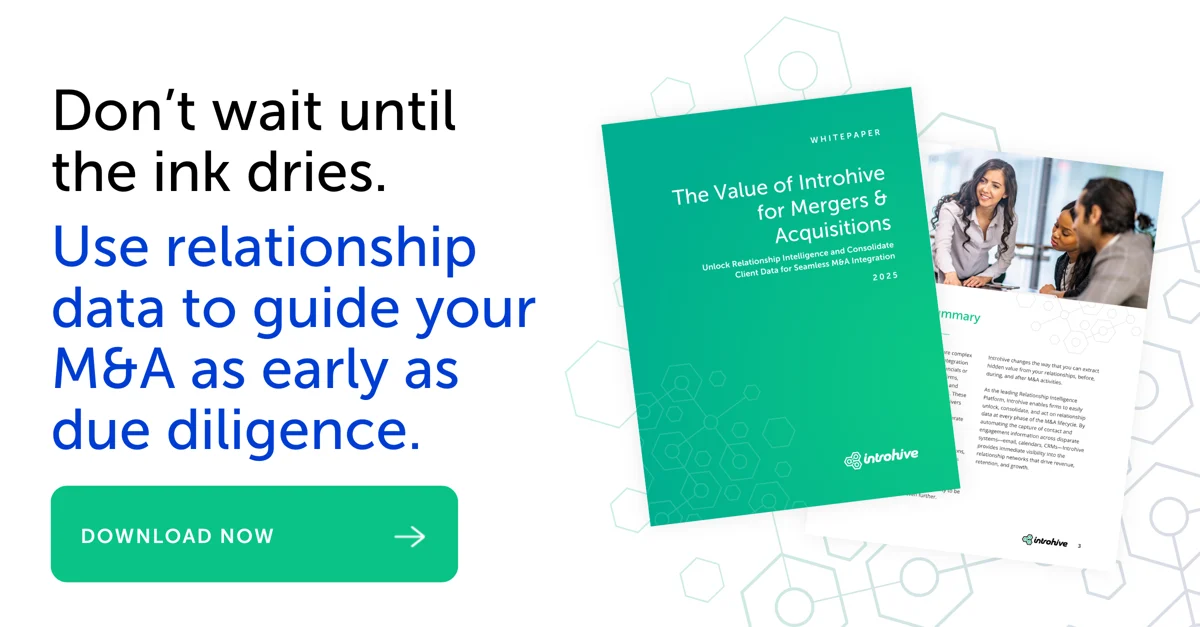As professional services firms push for growth in 2025 and beyond, many are turning to M&A as a way to enter new markets, bring in specialized expertise, strengthen client relationships, and grow revenue.
Recent research from the Hinge Research Institute underscores just how common this approach has become. An astonishing 81% of high-growth law firms engaged in M&A activity over the past year, compared to 50% of low-growth peers. In accounting, 63% of high-growth firms pursued mergers or acquisitions, a tactic contributing roughly 11% of their revenue. These numbers show just how integral M&A has become to growth strategies, but turning a deal into a successful M&A takes more than signing a contract.
Bringing firms together requires thoughtful integration of people, processes, and data – all while maintaining the trust of clients and employees.
That challenge came up more than once at Introhive’s recent Client Summit, where Luis Guevara (Forvis Mazars), along with peers Beth Moore (Grassi), and Tom Harper (Blue & Co.), shared during our fireside chat and client panel what they’ve learned about turning complex integrations into growth engines. Their insights show how firms can move beyond simply combining operations to unlocking real, measurable value from their mergers and acquisitions.
Table of contents
Here are four insider lessons for achieving a successful M&A.
Lesson 1: define a unified process, but don’t overcomplicate it
When accounting firms BKD and DHG announced their merger to form Forvis, Luis was tasked with a critical challenge: how do you merge two firms’ people, systems, and processes without overwhelming employees or clients?
Both firms had well-established ways of onboarding clients, managing CRM, and handling engagement workflows and neither was simply going to throw theirs out. To address this, Luis and his team coined the term “purple process”, which is a nod to blending BKD’s “red” way of doing things and DHG’s “blue” way into one unified approach.
“Our leadership was very directive about integrating, not innovating. Keeping it simple to get everyone onboarded with as little friction as possible,” Luis explained.
Instead of introducing entirely new systems or reinventing workflows, they focused on aligning existing ones quickly so that billing, engagement letters, and client onboarding could continue with minimal disruption.
However, Luis acknowledged that keeping it simple came at a cost: over time, manual workarounds and inconsistencies created technical debt – inefficiencies they’re now working to resolve.
The key takeaway? Starting with a simple, unified process is a smart way to stabilize operations and maintain morale during a merger. But it’s equally important to set clear milestones for improvement after the early stages of integration. Temporary solutions tend to harden into permanent inefficiencies if not addressed, which can eventually slow down growth. Successful M&A leaders balance short-term simplicity with a longer-term plan for modernization.

Lesson 2: put relationships at the center of your strategy
While processes and systems matter, at the heart of any firm are its relationships. During the Forvis integration, Luis emphasized that leadership deliberately focused on minimizing disruption for employees and clients and prioritizing integration over innovation so that their people could adjust. That sense of trust and commitment from employees carried the firm through and helped make the merger a success.
Tom extended this idea, describing how his firm now formally assesses the quality of client relationships before deciding to move forward with an acquisition.
“We now look at three things: financials, culture, and client relationships. If relationships aren’t a fit, we walk away… With our Detroit acquisition, the culture aligned and their relationships were excellent and we saw ROI in less than a year,” Tom said.
His team uses relationship intelligence to map the target firm’s client and referral networks, helping ensure the relationships are strong, not just the revenue.

Strong relationships are often the most valuable, and impactful, asset during an M&A. In addition to evaluating financials and culture, taking time to understand client and referral connections can help ensure continuity and strengthen trust throughout the transition. By actively measuring and supporting those relationships, you set the stage to retain clients, build confidence among staff, and realize the full potential of the acquisition.
Lesson 3: successful M&A means using data early – even before the contract is signed
A common challenge firms face is waiting until after the deal closes to evaluate client and market data, only to discover gaps, duplicates, or unserviceable records.
Forvis Mazars’ second integration, where they formed a global network, moved much faster because their first merger prompted them to align processes and clean their data. That preparation allowed them to bring the next firm into their systems more efficiently and start leveraging relationship data from the start.
Similarly, Tom at Blue & Co. shared how his firm developed their current approach to M&A after realizing the critical role that client relationships play in integration success. In earlier deals, they focused heavily on financials, but over time they expanded their due diligence to include a close examination of client and referral relationships.
“One of the pillars became client relationships. We bring Introhive to the target firm early to assess their relationships. They need to be proud of that data and willing to share it before we move forward,” Tom explained.
Using early data analysis as part of due diligence, Tom’s team can now validate whether a target firm’s client relationships align with their claims and, in some cases, uncover discrepancies or questions that help the team decide how to move forward thoughtfully.
Beth at Grassi has applied a similar mindset to the post-deal phase, using data to streamline onboarding and clarify key relationships as teams come together.
When her firm, an ESOP-owned accounting firm, acquired a 55-person Boston-based firm, she made sure marketing was involved from day one, and that senior managers were immediately set up with Introhive licenses.
“I’ve always believed marketing needs to be involved from day one and fortunately Grassi believes that too. Senior managers immediately got Introhive licenses right away, which meant I didn’t have to ask, ‘Do you have a spreadsheet of all your clients and contacts?’ …We don’t need that spreadsheet anymore; Introhive pulls the information directly for us. It’s the quickest and easiest way to collect data.”
These examples show how bringing data into the M&A process early (ideally during due diligence and continuing through integration) provides a clearer picture of the book of business and makes planning more effective. Reviewing relationship and client data at each stage highlights strengths, uncovers hidden opportunities, and informs thoughtful decisions about where to focus efforts for a successful M&A. This early, intentional use of data also builds trust by showing employees and clients that their connections are understood and valued.
Lesson 4: automate data capture to accelerate internal collaboration
Manually gathering contacts, updating CRMs, and cleaning spreadsheets can stall even the best-planned integration. Automating these tasks not only saves time, but also helps teams avoid confusion and overlapping efforts, particularly when it comes to managing shared relationships.
Luis’s team at Forvis Mazars built a Growth Optimizer (GO) dashboard, bringing together CRM, billing, and relationship data into a single, actionable view. Instead of expecting partners to log into multiple systems and hunt for information, the dashboard surfaced critical metrics like pipeline health, client engagement, and revenue trends, all in one place to help guide next best actions.
Beth at Grassi similarly emphasized automation, explaining how it helped her team navigate the complexity of a referral-driven business without stepping on each other’s toes.
“We’re very much a referral-based business. We rely on bankers, attorneys, insurance brokers, and charities to refer work to us. So organizing around centers of influence is really important and really, really tricky. We found there was a lot of stepping on toes. For example, this person had this relationship at a bank, and someone else would say, ‘Well, I have the best relationship.’ Introhive can tell us that. We did a big exercise around COIs, referral sources, and where the strength is. And it made a huge difference in what banks we should actually be focused on, who we want to partner with for events, webcasts, thought leadership and that data really helped drive and inform that strategy.”

By analyzing the data with Introhive, her team was able to identify where the strongest connections really were and use those insights to focus their efforts on the right partners for events, thought leadership, and business development.
Automation also builds confidence in your data and lets staff focus on what really matters: building relationships and driving growth. By streamlining routine processes and clarifying account ownership, automation helps integration run more smoothly, fosters collaboration, and creates a more productive, united team, all of which contribute to a successful M&A experience.
Final thoughts on achieving a successful M&A
Throughout these conversations, Luis, Beth, and Tom made it clear that successful M&A is about much more than signing a deal. The firms that create lasting value focus on aligning people, processes, and data in ways that strengthen relationships, build trust, and enable growth.
That means taking a phased, intentional approach. An approach that balances quick wins with long-term improvements, brings relationship and client data into view early, and makes it easy for teams to collaborate through automation and clarity. The most successful integrations don’t just combine firms on paper; they unlock the full potential of the people and clients at the heart of the business.
If your firm is preparing for a merger or acquisition, Introhive can help. Request a demo to see how our platform helps firms surface actionable insights, foster stronger collaboration, and set the stage for successful M&A and sustainable growth. Or explore our M&A Guide for more practical steps to support your M&A strategy.



